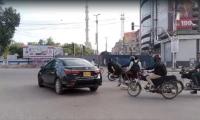Current approaches to drug control in Asia overwhelmingly criminalise people already on the margins of society - those who use or are dependent on drugs - with dire consequences for them, their families and communities.
Among the harshest penalties imposed in the name of the ‘war on drugs’ is the mandatory death penalty for drug trafficking. In the past decade, more than 3,940 people globally were executed for drug offences. Half of all countries worldwide that impose capital punishment for drug crimes are in Asia.
Then there is the surge in extrajudicial killings of individuals accused and suspected of using or selling drugs, a grave human rights violation promoted by Philippine President Rodrigo Duterte, which now seems to be spreading across the region. During a visit to the Philippines earlier this month, Sri Lanka’s President Maithripala Sirisena praised the country’s state-sanctioned massacre as “an example to the world” and vowed to bring back the death penalty for drug offenders. In May 2018, Bangladesh launched a Philippine-style ‘war on drugs’ which resulted in more than 100 deaths and 12,000 drug arrests in its first 15 days.
Several countries in Asia, including Brunei, Malaysia and Singapore, still condone caning, whipping, lashing or flogging for people accused of drug use, including children. Even if corporal punishment is banned, individuals caught using drugs continue to be treated like criminals in many places across Asia.
Instead of being offered drug dependence treatment, harm reduction, counselling and other psycho-social support services, suspected drug users often face forced urine testing, mandatory registration with law enforcement authorities, imprisonment and detention.
In the Philippines, students undergo mandatory drug testing at a great cost to an under-funded educational system. Drug offenders make up to 50-70 percent of total prison populations in Indonesia, Thailand and Myanmar, clogging prisons that are already above capacity. In Thailand, a staggering 80 percent of the 47,000 women in prison are incarcerated on a drug offence, usually a non-violent one, like possession or personal use.
Not content with locking up people who use drugs in prisons, many governments also detain them in the name of treatment and rehabilitation. In the 1990s China launched its ‘war on drugs’ and opened such detention facilities to imprison drug users who were deemed threatening to national security or public order in order to ‘re-educate’ them through forced labour.
Despite being widely condemned by UN agencies, academics and civil society for employing forced labour, torture and other abuses of human rights, such facilities remain prevalent in Cambodia, China, Laos, Malaysia, Myanmar, the Philippines, Singapore, Thailand, and Vietnam; as of 2014, 450,000 people were being held in such centres.
Meanwhile, provision of effective, voluntary and evidence-based healthcare for drug users in Asia lags behind the rest of the world. Drug treatment quality is inconsistent. In India and Nepal, allegations of abuse, torture, death and lack of access to treatment for drug dependence at private drug treatment centres abound.
On top of these various failures, politicians in the region have increasingly started using the drug problem for political gains. This has eroded democratic institutions, promoted corruption and normalised stigma and discrimination against people who use drugs. In the Philippines, for instance, the so-called ‘drug menace’ has been invoked to justify authoritarian measures, weaken civilian authority, and imprison critics such as Senator Leila de Lima, an outspoken opponent of Duterte’s drug war. So have these brutal anti-drug campaigns at least achieved their stated goal of reducing drug markets?
Data released by the UN Office on Drugs and Crime shows that this is not the case. Despite costly eradication efforts, illicit plant cultivation has persisted in most areas, increased (in places like Myanmar) or even skyrocketed (in Afghanistan). Drug use levels have also remained high or even increased. It is estimated that in Asia some 17 million people use amphetamines. In Southeast Asia in particular, amphetamines and ecstasy have been identified as increasingly worrying problem by local authorities, but no reliable data on use is available. There has also been a significant increase in seizures of methamphetamine tablets and in cannabis in the region between 2008 and 2015. This, however, does not point to effective interdiction efforts, but to the continued expansion and dynamism of the illicit drug market, despite tremendous law enforcement efforts to curb it.
This article has been excerpted from: ‘Has the decade-old war on drugs in Asia succeeded?’
Courtesy: Aljazeera.com
An aeroplane of the national flag carrier of Pakistan is seen in this file photo. — AFPWhile Pakistan considers...
Representational image of a graph depicting various variables. — APP/FileInitiated by the centre and fiercely...
In this picture taken on April 16, 2023, people throng a market area during shopping in Lahore. — AFPOne of the...
Honour crimes also target men. In Sikandar Ali Lashari vs The State, SHC upheld conviction passed by ATC for honour...
If Sindh earmarks Rs20 million per police station, it will cost only Rs10 billion to make them effective first...
A complex and difficult policy environment seems to be highlighted by US’s recent application of sanctions on...







